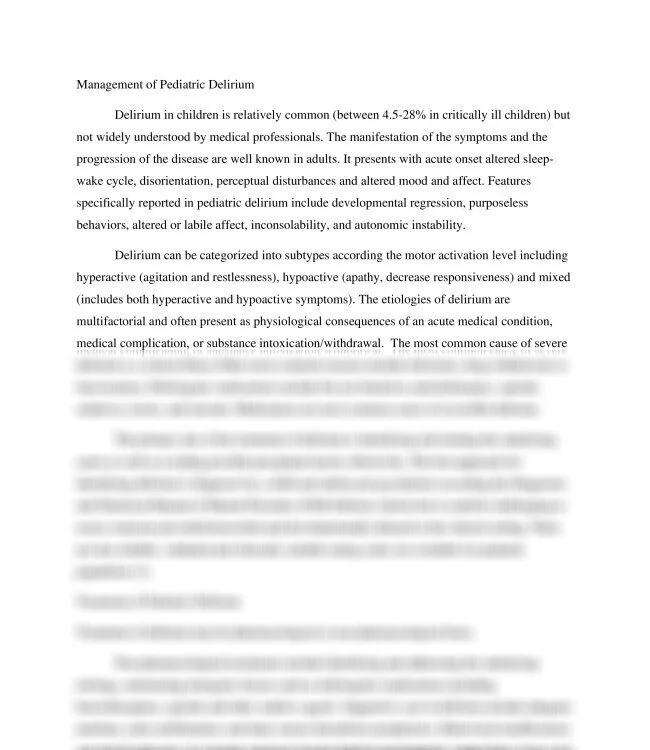Management of Pediatric Delirium
Management of Pediatric Delirium
& (1). (10-15 (2010). (3.5-10 (<20 (<45kg) (<age5) (>15kg) (>45 (>age5) (Age (FDA) (Fifth (IV) (Initial (Loading (PO) (age (agitation (apathy, (between (divided (e.g., (ed), (includes ) -Avoid -IV -Optimize -Prevent -Promote -Reduce, -Remove 0-1) 0.01-0.05 0.01-0.08 0.02 0.025 0.05 0.1-0.2 0.15 0.2-0.5 0.2-2.5 0.3-0.5 0.5 0.5-1 1- 1-3) 10 13-17) 175 1mg/day 2- 2-4 2.5 2.5-20 20 2007, 2012;22(2):126-30 2015 2019. 25, 25-100 3- 3-18) 30 3mg/day 4 4- 4.5-28% 485-490. 6 69(5), ; A A., Accessed Administration Adolesc Adolescent Agency Allied Antipsychotic Association Atypical Avoid B., Behavioral Bisson, Chapple, Child Comes Comments Currently, Deliriogenic Delirium Diagnostic Disorders Dose Drug E, E., EPS Edition) Eeles, FDA Features Federal Geneva: H, Haloperidol Health Health. Hudson, I. IACAPAP IM IM: INTERVENTION INTERVENTIONS IV IV: In Inc. International Intramuscular Intravenous Ista It J J. JM JNM, Journal Karapareddy, Kluwer Knoester Lack Lexicomp. Loading MEDICATION ML. Maintenance Management Manual Maximum May Medications Melatonin Mental Minimize Molag Multicomponent Muthuvelu, NON Non-pharmacological ODT: OH. Olanzapine Optimize Oral Other P., PHARMACOLOGICAL PO PO/IM/ODT PO/IV/IM/ PO/ODT/Oral PO: Pediatric Per Pharmacologic Phillips, Professions Promote Provide Psychiatry Psychopharmacol. QT Quetiapine Range References Removing/minimizing Rey Risperidone S., SB, Schieveld Statistical Strategies Support Supportive T. Tahir, The There Treatment Turkel Use Usual V., Wolters a abnormality, according activation acute addressing adequate adjusting administered adolescent adults. advantage affect, affect. after agents agents. agitation, aim al. alarm also altered among an analgesia and animals) anticholinergic anticholinergics, antipsychotics antipsychotics, approach approach. approved are around as assess at atypical autonomic available avoid avoiding basis. be bedtime been behaviors behaviors, benzodiazepines benzodiazepines, best black both box but by calendars, can care caregiver, categorized cause challenging changes child child. children children) circadian clinical clinically clocks, combat common companionship. complication, condition, consequences constant continues control control, controlled conversation could criteria critical critically cues cycle cycle, cycle. daily) day decrease decreases deep delayed deliriogenic delirium delirium. delirium: deprivation developmental developmentally devices/tubes/catherization diagnosis disease disintegrated disintegrating disorientation, display disturbance disturbance, disturbances dosage: dosages dose dose) dose)4 dose3 dose: drug due e-Textbook ear early effective effectively. effects effects. electrolyte environment environment, equally equipment, establish et etiologies etiology, even exposure eye factors familiar family favorite fewer for form frequent haloperidol have having health, helps hemodynamic higher hyperactive hypoactive hypoxia, iatrogenic identifying if ill illness in include including inconsolability, infection infections, instability instability. intervention. interventions interventions. into intoxication/withdrawal. intoxications. intravenously invasive is issued it kg kg) known labile level light limited limiting lower lowest manifestation mask maximum may medical medication medications mg mg/day mg/day(<20-45 mg/day(<45 mg/kg mg/kg/day minimizing minutes mixed mobility mobilization, modifications mood more most motor much multifactorial natural necessary no noise non-pharmacological nonpharmacologic normalizing not nutrition, objects of often olanzapine, older on once ones onset opiates, opioids opioids, or orally orient orientation other others, overstimulating patient pediatric per perceptual pharmacological photos, physical physiological placebo plug population possible possible. practical practice, precipitant prefer presence present presents preverbal/nonverbal primary professionals. profile progression prolongation prolongation. prophylaxis. providers psychiatrist psychosomatic purposeless quetiapine quetiapine, quick randomized rapid rather rating reasons reassurance reassuring reduce regarded regression, related relatively reliable, reminders. reorientation reported research, response responsiveness) restlessness), restraints. reversible rhythm risk risperidone, room. safe safety scales scores sedation sedative sedatives, setting. severe should show side significant single sleep sleep-wake solution someone specifically staff steroids. strategies studies stuffed substance substitute subtypes such suitable symptom symptoms symptoms). tablet tactile talking taper than that the there thrombosis through times to too toxins, treat treating treatment treatments trial typical underlying understood unnecessary use used useful using validated venous verbal versus visible volumes warning well which widely with withdrawals – …
Management of Pediatric Delirium
Delirium in children is relatively common (between 4.5-28% in critically ill children) but not widely understood by medical professionals. The manifestation of the symptoms and the progression of the disease are well known in adults. It presents with acute onset altered sleep-wake cycle, disorientation, perceptual disturbances and altered mood and affect. Features specifically reported in pediatric delirium include developmental regression, purposeless
